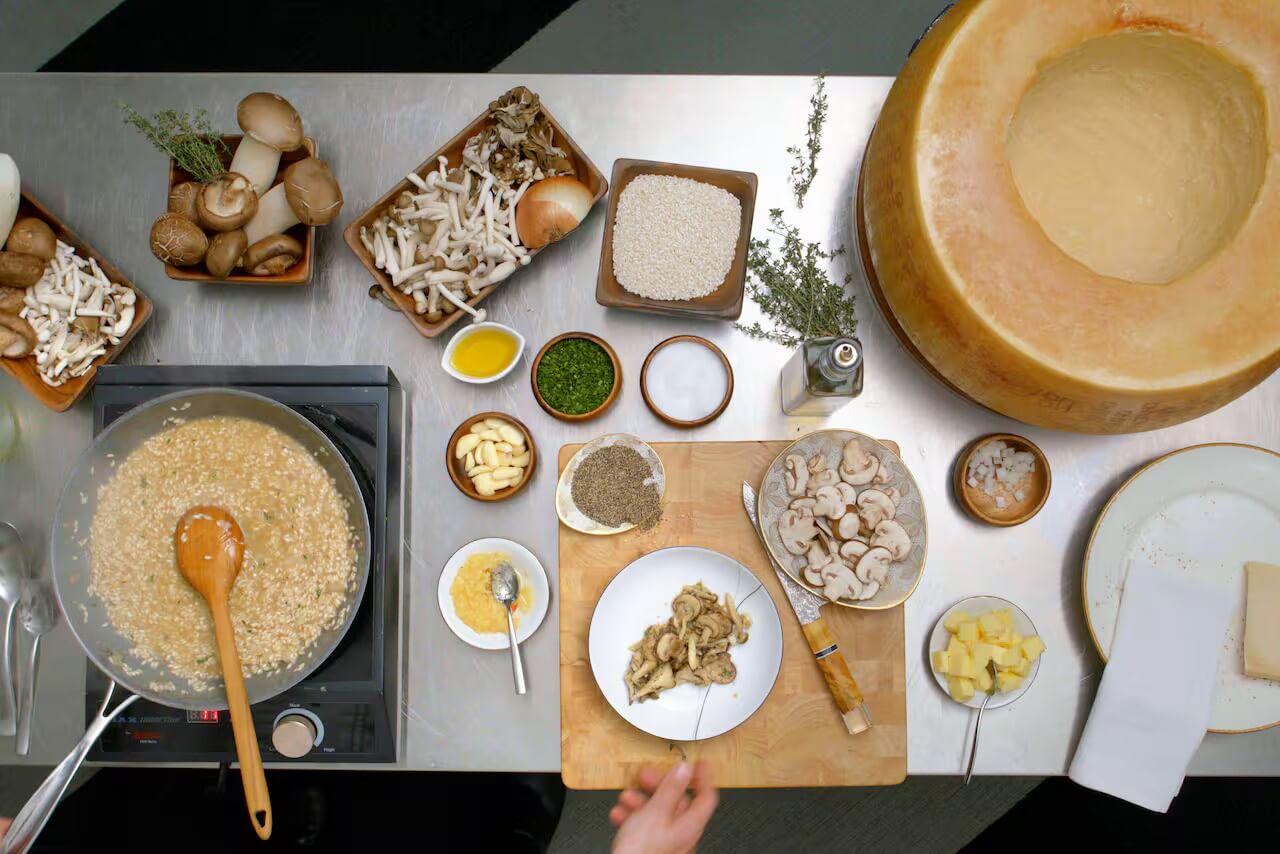Risotto is a classic Italian dish loved for its creamy texture and endless flavor possibilities. Learning how to make risotto at home allows you to enjoy this delicious meal whenever you desire.
Whether you’re preparing it for a weeknight dinner or a special occasion, mastering the basic steps of making how to make risotto will ensure you achieve the best results. In this guide, we’ll walk you through the essential steps, tips for achieving the perfect texture, and how to enhance your risotto with creative variations and perfect pairings.
How To Make Risotto: Essential Steps And Ingredients
Making risotto requires just a few simple ingredients and some attention to technique. Here’s a breakdown of the essential steps and ingredients to get started:
1. Key Ingredients
- Arborio rice: This short-grain rice is essential for risotto due to its high starch content, which gives the dish its signature creamy texture.
- Broth: Whether you use chicken broth, vegetable broth, or beef broth, the broth is the liquid base that infuses flavor into the rice. Keep it warm during the cooking process.
- Butter and Olive Oil: These fats are crucial for sautéing the aromatics and adding richness to the risotto.
- Parmesan Cheese: Freshly grated parmesan cheese is essential for adding a creamy texture and savory depth to the finished dish.
- Onion: A finely chopped onion is usually sautéed as a base flavor for the risotto.
2. Cooking Steps
- Sauté the onion in butter and olive oil until soft.
- Add the risotto rice and stir to coat it in the fats.
- Deglaze with white wine (optional) and let it absorb.
- Gradually add warm broth, one ladle at a time, stirring constantly until the rice absorbs the liquid. Continue this process until the rice is tender and creamy.
3. Finish with Butter and Cheese
- Stir in parmesan cheese and butter for extra creaminess and flavor. Season with salt and pepper to taste.
By following these essential steps, you’ll be on your way to mastering how to make risotto at home.
Mastering The Texture: Tips For Perfect Risotto
Achieving the perfect creamy texture is key to making risotto stand out. Here are some tips to ensure you get the best texture every time:
1. Gradually Add Liquid
- Add the warm broth one ladle at a time, allowing it to absorb before adding more. This method gives the rice time to release its starch and achieve a smooth, creamy texture. Avoid rushing the process.
2. Stir Constantly
- Stirring helps release the starch from the rice, which is crucial for creating that signature creamy texture. Make sure to stir frequently, but don’t overdo it. Gentle stirring is all that’s needed.
3. Use Warm Broth
- Always use warm broth for the risotto. Adding cold broth will lower the temperature and slow down the cooking process, leading to uneven texture.
4. Don’t Overcook the Rice
- The perfect risotto should be al dente, meaning tender but with a slight firmness when bitten. Overcooked rice will result in mushy risotto, so be sure to stop cooking when the rice is just right.
By mastering these techniques, you’ll consistently create the perfect creamy texture for your risotto.
How To Make Risotto: The Role Of Broth And Seasonings
The broth and seasonings you choose play a significant role in the flavor profile of your risotto. Here’s how they contribute to the dish:
1. Broth
- The broth is the main flavoring agent in risotto. A rich, homemade or high-quality store-bought broth adds depth and enhances the overall taste of the dish. The richness of the broth infuses the rice and creates the creamy texture you desire.
2. Seasonings
- Salt and pepper are essential to season your risotto to taste.
- Fresh herbs like thyme, rosemary, and sage can be added to enhance the flavor and aroma. Stir them in towards the end of cooking or sprinkle on top just before serving.
- A touch of lemon zest or garlic can add brightness and complexity to your dish.
The key to delicious risotto is balancing the flavors from the broth and seasonings to create a harmonious, rich dish.
Creative Variations: Adding Flavor To Your Risotto
Once you’ve mastered the basic recipe for risotto, you can get creative by adding different ingredients to customize the flavor. Here are some variations to consider:
1. Mushroom Risotto
- Adding sautéed shiitake, portobello, or cremini mushrooms adds an earthy depth to your risotto. The mushrooms pair wonderfully with the creamy rice.
2. Seafood Risotto
- For a luxurious twist, try adding shrimp, scallops, or lobster to your risotto. The seafood adds a delicate sweetness that complements the richness of the rice.
3. Lemon and Asparagus Risotto
- For a lighter, fresher flavor, try adding lemon zest and asparagus. The bright citrus flavor complements the creaminess of the risotto and makes it a great spring dish.
4. Spinach and Ricotta Risotto
- Stir in fresh spinach and ricotta cheese for a healthy, creamy risotto option. The spinach adds color and flavor, while the ricotta creates a smooth and velvety texture.
Feel free to experiment with these creative ideas to make your risotto unique.
Pairing Risotto With The Best Sides And Wines
To complete your risotto meal, pairing it with the right sides and wines can elevate the entire dining experience. Here are some great pairing ideas:
1. Side Dishes
- Roasted Vegetables: Serve your risotto with roasted asparagus, zucchini, or carrots for a light contrast to the rich, creamy rice.
- Salads: A fresh, tangy salad with arugula or spinach and a light vinaigrette balances the heaviness of the risotto.
- Grilled Meats: Pair risotto with grilled proteins like chicken, steak, or fish. Their simplicity complements the complex flavors of risotto.
2. Wine Pairings
- White Wines: A crisp Pinot Grigio or Sauvignon Blanc works well with vegetable-based risottos or those with seafood.
- Red Wines: If you have a rich, meaty risotto, try pairing it with a light red wine like Pinot Noir to enhance the flavor without overpowering it.
By pairing your how to make risotto with the right sides and wines, you can create a well-rounded and satisfying meal.
See you in the next post,
Anil UZUN


